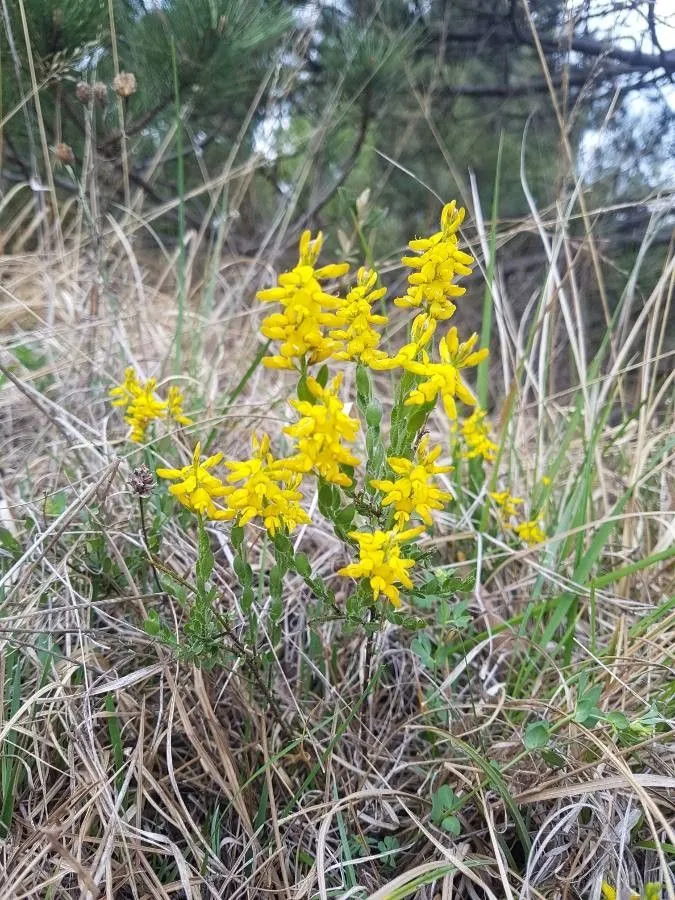
Author: L.
Bibliography: Sp. Pl.: 710 (1753)
Year: 1753
Status: accepted
Rank: species
Genus: Genista
Vegetable: Unknown
Observations: Europe
The German greenweed, scientifically known as Genista germanica, is a fascinating plant species that has its roots deeply embedded in the European landscape. This perennial shrub belongs to the Fabaceae family, a large and economically significant family of flowering plants commonly referred to as the legume, pea, or bean family.
Genista germanica was first described in detail in 1753 by the renowned botanist Carl Linnaeus, and its formal citation can be found in his seminal work, “Species Plantarum,” on page 710. This work laid the foundation for modern botanical nomenclature and continues to be a critical reference for plant taxonomy.
Native to Europe, the German greenweed has adapted well to various habitats across the continent. It typically thrives in open, sunny locations with well-drained soils, often found on heathlands, grasslands, and sometimes in open woodlands. This adaptability has allowed it to spread across a wide geographic range, making it a common sight in many European countries.
The plant itself is characterized by its dense, bushy growth, usually reaching up to 1.5 meters in height. The stems are woody and branched, bearing small, narrow leaves that contribute to its overall hardy appearance. During the blooming season, Genista germanica produces clusters of bright yellow flowers, which are not only visually striking but also play a crucial role in the local ecosystem by attracting various pollinators.
In addition to its ecological importance, the German greenweed has been noted for its historical uses. Traditionally, parts of the plant were used in herbal medicine, although these practices have dwindled with the advent of modern pharmacology. Nonetheless, the plant’s significance in biodiversity and its role in supporting wildlife habitats cannot be overstated.
Overall, the German greenweed stands as a resilient and beneficial species within the European flora, reflective of the rich botanical heritage and diversity of the region. Whether observed for its bright yellow blossoms or appreciated for its ecological contributions, Genista germanica remains a noteworthy example of nature’s enduring beauty and tenacity.
Deu: deutscher ginster
Dan: tysk visse
Nld: duitse brem
Fin: saksanväriherne
Swe: saksanväriherne, tysk ginst, tagginst
Nno: tysk ginst
Nob: tysk ginst
En: German Greenweed, German Wood-waxen, Spiny Furze
Az: Alman nazı
Be: Жаўтазель германскі
Bg: Немска жълтуга
Cs: Kručinka německá
Da: Tysk visse
Nl: Duitse brem
Et: Saksa leetpõõsas
Fi: Saksanväriherne
Fr: Genêt d’Allemagne
De: Deutscher Ginster
It: Bulimacola, G. spinosa, Ginestra spinosa
Nb: Tysk ginst
Nn: Tysk ginst
Pl: Janowiec ciernisty
Sk: Kručinka nemecká
Sv: Tysk ginst, Saksanväriherne, Tagginst
Uk: Дрік германський
Taken May 26, 2018 by Heinz Gass (cc-by-sa)
Taken May 27, 2016 by Martin Bishop (cc-by-sa)
Taken May 19, 2022 by Ornel Jokerrr83 (cc-by-sa)
Taken Jun 14, 2021 by mimi chatain (cc-by-sa)
Taken May 15, 2022 by Ernst Fürst (cc-by-sa)
Taken May 3, 2021 by Cristian Zanella Cristian Zanella (cc-by-sa)
Taken Jul 1, 2020 by Sally Leat (cc-by-sa)
Taken Jun 17, 2020 by barb_ma_hlad (cc-by-sa)
Taken May 15, 2022 by Ernst Fürst (cc-by-sa)
Taken Apr 20, 2021 by Gianfranco Carignano (cc-by-sa)
Taken Jan 1, 1800 by Tela Botanica − Thierry Pernot (cc-by-sa)
Taken Jun 23, 2018 by Tela Botanica − Jean-Claude Bouzat (cc-by-sa)
Taken Jun 23, 2018 by Tela Botanica − Jean-Claude Bouzat (cc-by-sa)
Taken May 1, 2019 by samuel jean (cc-by-sa)
Taken May 15, 2022 by Ernst Fürst (cc-by-sa)
Taken Aug 15, 2015 by Photoflora – Jean-Luc TASSET (©)
Taken May 15, 2009 by Photoflora – Benoit BOCK (©)
Taken May 15, 2009 by Photoflora – Benoit BOCK (©)
Taken Jan 1, 1800 by Tela Botanica − Thierry Pernot (cc-by-sa)
Taken Jun 25, 2010 by Tela Botanica − Mathieu MENAND (cc-by-sa)
Taken Oct 28, 2022 by Jindřich Jindřich (cc-by-sa)
Taken Aug 15, 2006 by Photoflora – Bernard TILLY (©)
Taken Aug 15, 2006 by Photoflora – Benoit BOCK (©)
Taken May 15, 2009 by Photoflora – Benoit BOCK (©)
Taken Jun 23, 2018 by Tela Botanica − Jean-Claude Bouzat (cc-by-sa)
Taken Jan 1, 1970 by Photoflora – L’Abbé COSTE (©)
Taken May 15, 2014 by Photoflora – Benoit BOCK (©)
Taken Jan 1, 1800 by Tela Botanica − Thierry Pernot (cc-by-sa)
Taken Jan 1, 1800 by Tela Botanica − Daniel MATHIEU (cc-by-sa)
Taken Jun 25, 2010 by Tela Botanica − Mathieu MENAND (cc-by-sa)
© copyright of the Board of Trustees of the Royal Botanic Gardens, Kew.
Family: Myrtaceae Author: (F.Muell.) K.D.Hill & L.A.S.Johnson Bibliography: Telopea 6: 402 (1995) Year: 1995 Status:…
Family: Rubiaceae Author: Pierre ex A.Froehner Bibliography: Notizbl. Bot. Gart. Berlin-Dahlem 1: 237 (1897) Year:…
Family: Sapindaceae Author: Koidz. Bibliography: J. Coll. Sci. Imp. Univ. Tokyo 32(1): 38 (1911) Year:…
Family: Asteraceae Author: A.Gray Bibliography: Pacif. Railr. Rep.: 107 (1857) Year: 1857 Status: accepted Rank:…
Family: Fabaceae Author: Medik. Bibliography: Vorles. Churpfälz. Phys.-Ökon. Ges. 2: 398 (1787) Year: 1787 Status:…
Family: Aspleniaceae Author: (Cav.) Alston Bibliography: Bull. Misc. Inform. Kew 1932: 309 (1932) Year: 1932…